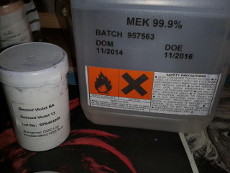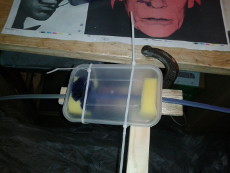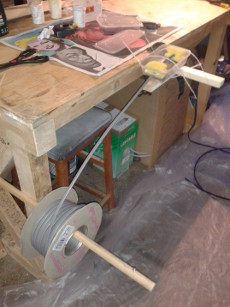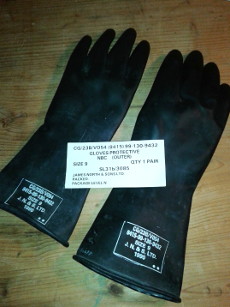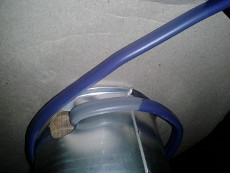Dyeing PVC Electrical Cables
I wanted to colour some grey PVC mains 2.5mm2 "Twin and Earth" cable to help distinguish / easily identify an Extra-Low Voltage (ELV) ring main in my house.
After some research, I discovered solvent dyeing was the best way to colour PVC. This method is used in industrial applications to colour cables.
How does it work?
When a solvent and a dye are mixed, they can be applied to any PVC item. The solvent gently etches the very outer surface of the PVC (just molecules deep), and leaves a deposit of the dye in the PVC, colouring the cable.
Setup:
I bought the dyes from FastColours.com as small sample pots, most other suppliers have minimum order quantities of 1kg...
You simply add some solvent-dye to a solvent (I used Methyl Ethyl Ketone, MEK) and mix well. Check first that any plastic containers won't melt when you fill them with the solvent! You only need a really tiny amount of dye in the solvent, the sample pots I bought will last me a lifetime!
Using an old Chinese takeaway box with a small hole cut in either end, I added sponge inside it (See Fig 2 and 3). This sponge was soaked in the dyed solvent, and the cable poked right through the middle.
I rigged up my bench to mount the cable reel to rotate, and the dyeing box. I laid out a plastic sheet on the floor, and wearing British Army NBC gloves, drew the entire length of the cable through the box, piling it onto the sheet on the floor. After running it through once, I then reversed the process and in winding the cable back on the reel, gave it a second dyeing.
The solvent evaporates within seconds, and the PVC surface stays soft to the touch for a few more seconds before toughening up again.
Caution!
Solvents can be harmful when absorbed into your skin, however they also have a nasty side effect where they carry with them any dirt that's on your skin at the time, and pass this into your body and blood (in this case a dye as well). Please use good gloves (Fig 4) to avoid dermatitis and other conditions.
Any activity where solvents like MEK are used should be carried out in a well ventilated area, I had the garage door open during this job, as it doesn't half stink!
Please read the HSE's website for guidance on working with solvents.
Result:
Overall, pretty good, see Fig 5. However, I found that the speed at which you pull the cable through the solvent dye really affects the depth of colour in the finished cable, the slower the darker, the faster, the lighter.
Improvements:
A motorised feeding system would make the results more consistent if the cable was to be pulled through at a constant rate / speed.
The sponge did a good job, but was beginning to break down by the end of the task and shed particles onto the cable. Next time I'll try an old rag / cloth instead.
